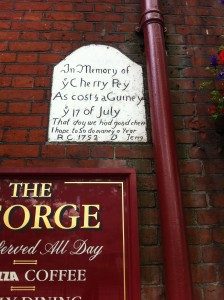
May we propose a new Wanstead tradition – the marking of Cherry Pie Day, as immortalised in the somehow unexplained plaque on the side of the George. The sign dates from 1752 – well before the current building on the site. Wanstead historian Winifred Phillips thought that it perhaps celebrated a fruit heist (our phrase, not hers), but no one really knows.
It is however one of the best known Wanstead landmarks, so whatever the story, let’s start marking the day. Suggestions for ways to mark it are welcome.
Reader David Ridgwell writes:
I heard an explanation from an old resident years ago, a workman was up a ladder leaned against the wall and stole a cherry pie from a vendor who passed by with a tray of cherry pies on his head. The workman was brought before court for this minor crime and fined half a guinea, hence the “cherry pey as cost half a guinea.”. However as you point out, as the current George building is only just over a hundred years old, how this plaque came to be in the wall or where it was from originally, I have no idea.

I heard an explanation from an old resident years ago, a workman was up a ladder leaned against the wall and stole a cherry pie from a vendor who passed by with a tray of cherry pies on his head. The workman was brought before court for this minor crime and fined half a guinea, hence the “cherry pey as cost half a guinea.”. However as you point out, as the current George building is only just over a hundred years old, how this plaque came to be in the wall or where it was from originally, I have no idea.
Rocky Gutierrez
Love this. We could have a big picnic every year on the green and everyone bake/cook something with cherries in. We could sell them and each year buy something with the proceeds either for Wanstead like the Christmas Tree or for Haven House
Excellent idea. Please let it happen
If we could have a cottage pie bakeoff as well, my husband would be happy for eternity.
and wouldn’t it be wonderful if one day Wanstead became known for its local delicacy such as places like Bakewell etc. So get baking boys n girls 🙂
Cheryl Barry !! Ha x
Love it!! X
Tom Howl in the Facebook comments has it — there was a previous George pub in the same spot as the current pub, and the story goes that the plaque (and the theft it refers to) dates from that building, and was preserved on the “new” building. There’s also a theory that the pie theft story never really happened, but it’s a nice curiosity all the same.
I need to check my sources – but I remember reading that there are no independent references to the ‘Cherry Stone’ before the George Inn was built, which would point towards the stone being no older than the pub and a nice little fake.
Also, the use of ‘ye’ (which, by the way, is pronounced ‘the’ not ‘ye’, because the ‘y’ is actually the Anglo-Saxon letter ‘thorn’ which had a ‘th’ sound) had largely (but not totally) fallen out of use by the middle of the eighteenth century.
It all points to an elaborate (but nevertheless charming) bit of historical forgery! I would love to be wrong on this one.
The Shady Old Lady has more detail on this: http://www.shadyoldlady.com/location.php?loc=630
The story has come under severe strutiny – the stone was placed there by the then-publican David Jersey (the name has been changed in repeated re-carvings of the stone to D Terry), who was born in East Ham in 1697 of a family of East Ham innkeepers; their family grave is still prominent in East Ham churchyard, though David Jersey, who died in 1754, is buried in Wanstead.
And the ‘Ye’ looks genuine enough Juan if you read this from Wiki. The entry talks of usage in Early Modern English, which takes it up to the Restoration and Interregnum, not so long before 1752. The Cherry Pie is genuine. https://en.wikipedia.org/wiki/Ye_(pronoun)
Confusion with definite article/
“Ye” is also sometimes used to represent an Early Modern English form of the word “the” (traditionally pronounced /ðiː/), such as in “Ye Olde Shoppe”. “Ye” was often written “EME ye.svg” (here the “e” is written above the other letter to save space but it could also be written on the line).
@iamarover
Hmm.
The Interregum began in 1649 and the Restoration was 1660. So a period of 103 years to 92 years before the Stone’s alleged creation. Hardly ‘not so long before 1752’ !
Still no hard evidence here – so sadly, the Cherry Stone isn’t necessarily genuine because you say it is. Speculation that D. Terry is possibly another D. Terry who lived in the region at the same time simply does not stand up to scrutiny and is, at best, a highly speculative conclusion.
Also, I can’t actually see what you’re adding to the conversation regarding ‘ye’ other than backing up what I’ve already said!
I would love it to be genuine – but armed only with the internet hearsay you present, you simply cannot say this.